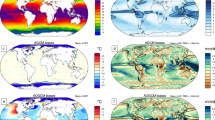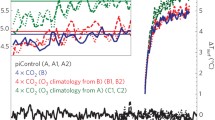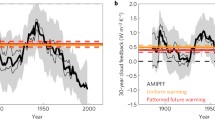Abstract
Radiative feedbacks are known to determine climate sensitivity. Global top-of-atmosphere radiation correlations with surface temperature performed here show that decadal variability in surface temperature is also reinforced by strong positive feedbacks in models, both in the long wave (LW) and short wave (SW), offsetting much of the Planck radiative damping. Net top-of-atmosphere feedback is correlated with the magnitude of decadal temperature variability, particularly in the tropics. This indicates decadal-timescale radiative reinforcement of surface temperature variability. Assuming a simple global ocean mixed layer response, the reinforcement is found to be of a magnitude comparable to that required for typical decadal global scale anomalies. The magnitude of decadal variability in the tropics is uncorrelated with LW feedbacks, but it is correlated with total SW feedbacks, which are, in turn, correlated with tropical SW cloud feedback. Globally, water vapour/lapse rate, surface albedo and cloud feedbacks on decadal timescales are, on average, as strong as those operating under climate change. Together these results suggest that some of the physical processes responsible for setting the magnitude of global temperature change in the twenty-first century and climate sensitivity also help set the magnitude of the natural decadal variability. Furthermore, a statistically significant correlation exists between climate sensitivity and decadal variability in the tropics across CMIP5 models, although this is not apparent in the earlier generation of CMIP3 models. Thus although the link to sensitivity is not conclusive, this opens up potential paths to improve our understanding of climate feedbacks, climate sensitivity and decadal climate variability, and has the potential to reduce the associated uncertainty.









Similar content being viewed by others
Notes
The Planck cooling refers to the hypothetical TOA LW radiative cooling that would take place for the climate system under a given surface warming if the atmosphere warmed uniformly with height at the same rate the surface temperature change (i.e. no lapse rate changes), and there were no changes to other radiatively sensitive parameters in the atmosphere/surface, such as to water vapour, clouds or surface albedo. The Planck cooling is not strictly a climate ‘feedback’ but instead represents the radiative damping of the climate system that would occur in the absence of feedbacks (Bony et al. 2006). Here it is listed in tables as a ‘feedback’ for simplicity of presentation.
References
Andrews T, Gregory JM, Webb MJ, Taylor KE (2012) Forcing, feedbacks and climate sensitivity in CMIP5 coupled atmosphere-ocean climate models. Geophys Res Lett 39(712):L09. https://doi.org/10.1029/2012GL051607
Andrews T, Gregory JM, Webb MJ (2015) The dependence of radiative forcing and feedback on evolving patterns of surface temperature change in climate models. J Clim 28:1630–1648
Armour KC, Bitz CM, Roe GH (2013) Time-varying climate sensitivity from regional feedbacks. J Clim 26:4518–4534. https://doi.org/10.1175/JCLI-D-12-00544.1
Bellenger H, Guilyardi E, Leloup J, Lengaigne M, Vialard J (2014) ENSO representation in climate models: from CMIP3 to CMIP5. Clim Dyn 42:1999–2018. https://doi.org/10.1007/s00382-013-1783-z
Bony S, Dufresne J-L (2005) Marine boundary layer clouds at the heart of tropical cloud feedback uncertainties in climate models. Geophys Res Lett 32:L20806. https://doi.org/10.1029/2005GL023851
Bony S, Colman RA, Kattsov V, Allan RP, Bretherton CS, Dufresne J-L, Hall A, Hallegatte S, Holland MM, Ingram W, Randall DA, Soden BJ, Tselioudis G, Webb MJ (2006) How well do we understand and evaluate climate change feedback processes? J Clim 19:3445–3482
Boucher O, Randall D, Artaxo P, Bretherton C, Feingold G, Forster P, Kerminen V-M, Kondo Y, Liao H, Lohmann U, Rasch P, Satheesh SK, Sherwood S, Stevens B, Zhang XY (2013) Clouds and Aerosols. In: Stocker TF, Qin D, Plattner G-K, Tignor M, Allen SK, Boschung J, Nauels A, Xia Y, Bex V, Midgley PM (eds.) Climate change 2013: the physical science basis. Contribution of Working Group I to the Fifth Assessment Report of the Intergovernmental Panel on Climate Change. Cambridge University Press, Cambridge
Brown PT, Li W, Li L, Ming Y (2014) Top-of-atmosphere radiative contribution to unforced decadal global temperature variability in climate models. Geophys Res Lett 41:5175–5183, https://doi.org/10.1002/2014GL060625
Brown PT, Li W, Xie S-P (2015) Regions of significant influence on unforced global mean surface air temperature variability in climate models. J Geophys Res Atmos 120:480–494. https://doi.org/10.1002/2014JD022576
Chen X, Tung K-K (2014) Varying planetary heat sink led to global-warming slowdown and acceleration. Science 345:897–903. https://doi.org/10.1126/science.1254937
Collins M, Knutti R, Arblaster J, Dufresne J-L, Fichefet T, Friedlingstein P, Gao X, Gutowski WJ, Johns T, Krinner G, Shongwe M, Tebaldi C, Weaver AJ, Wehner M (2013) Long-term climate change: projections, commitments and irreversibility. In: Stocker TF, Qin D, Plattner G-K, Tignor M, Allen SK, Boschung J, Nauels A, Xia Y, Bex V, Midgley PM (eds.) Climate change 2013: the physical science basis. Contribution of Working Group I to the Fifth Assessment Report of the Intergovernmental Panel on Climate Change. Cambridge University Press, Cambridge
Colman RA, Hanson LI (2013) On atmospheric radiative feedbacks associated with climate variability and change. Clim Dyn 40:475–492. https://doi.org/10.1007/s00382-012-1391-3
Colman RA, Hanson LI (2016) On the relative strength of radiative feedbacks under climate variability and change. Clim Dyn https://doi.org/10.1007/s00382-016-3441-8
Colman RA, Power SB (2010) Atmospheric feedbacks associated with transient climate change and climate variability. Clim Dyn 34:919–934. https://doi.org/10.1007/s00382-009-0541
Dai A, Fyfe JC, Xie S-P, Sai X (2015) Decadal modulation of global surface temperature by internal climate variability. Nat Clim Change 5:555–559. https://doi.org/10.1038/nclimate2605
Deser C, Phillips A, Bourdette V, Teng H (2012) Uncertainty in climate change projections: the role of internal Variability. Clim Dyn (2012) 38:527–546. https://doi.org/10.1007/s00382-010-0977-x
Flato G, Marotzke J, Abiodun B, Braconnot P, Chou SC, Collins W, Cox P, Driouech F, Emori S, Eyring V, Forest C, Gleckler P, Guilyardi E, Jakob C, Kattsov V, Reason C, Rummukainen M (2013) Evaluation of climate models. In: Stocker TF, Qin D, Plattner G-K, Tignor M, Allen SK, Boschung J, Nauels A, Xia Y, Bex V, Midgley PM (eds.) Climate change 2013: the physical science basis. Contribution of Working Group I to the Fifth Assessment Report of the Intergovernmental Panel on Climate Change. Cambridge University Press, Cambridge
Folland CK, Parker DE, Colman A, Washington R (1999) Large scale modes of ocean surface temperature since the late nineteenth century. In: Navarra A (ed) Beyond El Niño: decadal and interdecadal climate variability. Springer, Berlin, 374 pp, pp 73–102
Forster PMdeF (2016) Inference of climate sensitivity from analysis of earth’s energy budget. Ann Rev Earth Planet Sci 44:85–106
Forster PMdeF, Gregory JM (2006) The climate sensitivity and its components diagnosed from earth radiation budget data. J Clim 19:39–52
Fredriksen H-B, Rypdal K (2016) Spectral characteristics of instrumental and climate model surface temperatures. J Clim 29:1253–1268. https://doi.org/10.1175/JCLI-D-15-0457.1
Geoffroy O, Saint-Martin D, Olivié DJL, Voldoire A, Bellon G, Tytéca S (2012) Transient climate response in a two-layer energy-balance model. Part I: analytical solution and parameter calibration using CMIP5 AOGCM experiments. J Clim 26:1841–1857. https://doi.org/10.1175/JCLI-D-12-00195.1
Gregory JM, Andrews T (2016) Variation in climate sensitivity and feedback parameters during the historical period. Geophys Res Lett 43:3911–3920
Gregory JM, Andrews T, Good P (2015) The inconstancy of the transient climate response parameter under increasing CO2. Phil Trans R Soc A 373:20140417
Grose MR, Colman RA, Bhend J, Moise AF (2016) Limits to global and Australian temperature change this century based on expert judgment of climate sensitivity. Clim Dyn. https://doi.org/10.1007/s00382-016-3269-2
Hall A (2004) The role of surface albedo feedback in climate. J Clim 17:1550–1568. https://doi.org/10.1175/1520-0442(2004)017
Hall A, Manabe S (1999) The role of water vapour feedback in unperturbed climate variability and global warming. J Clim 12:2327–2346
Hansen J, Ruedy R, Sato M, Lo K (2010) Global surface temperature change. Rev Geophys 48:RG4004. https://doi.org/10.1029/2010RG000345
Hawkins E, Sutton R (2009) The potential to narrow uncertainty in regional climate predictions. Bull Am Meteor Soc 90:1095–1107
Hawkins E, Sutton R (2011) The potential to narrow uncertainty in projections of regional precipitation change. Clim Dyn 37:407–418
Hobbs WR, Massom R, Stammerjohn S, Reid P, Williams G, Meier W (2016) A review of recent changes in Southern Ocean sea ice, their drivers and forcings. Glob Planet Change 14:228–250
Hope C (2015) The $10 trillion value of better information about the transient climate response. Phil Trans R Soc A 373:20140429. https://doi.org/10.1098/rsta.2014.0429
IPCC (2013) Summary for policymakers. Climate change 2013: the physical science basis. Contribution of Working Group I to the Fifth Assessment Report of the Intergovernmental Panel on Climate Change. Stocker TF, Qin D, Plattner G-K, Tignor M, Allen SK, Boschung J, Nauels A, Xia Y, Bex V, Midgley PM (eds.). Cambridge University Press, Cambridge
Kirtman B, Power SB, Adedoyin JA, Boer GJ, Bojariu R, Camilloni I, Doblas-Reyes FJ, Fiore AM, Kimoto M, Meehl GA, Prather M, Sarr A, Schär C, Sutton R, van Oldenborgh GJ, Vecchi G, Wang HJ (2013) Near-term climate change: projections and predictability. In: Stocker TF, Qin D, Plattner G-K, Tignor M, Allen SK, Boschung J, Nauels A, Xia Y, Bex V, Midgley PM (eds.) Climate change 2013: the physical science basis. Contribution of Working Group I to the Fifth Assessment Report of the Intergovernmental Panel on Climate Change. Cambridge University Press, Cambridge
Kociuba G, Power SB (2015) Inability of CMIP5 Models to simulate recent strengthening of the walker circulation: implications for projections. J Clim 28:20–35. https://doi.org/10.1175/JCLI-D-13-00752.1
Kosaka Y, Xie S-P (2013) Recent global-warming hiatus tied to equatorial Pacific surface cooling. Nature 501:403–407. https://doi.org/10.1038/nature12534
Laepple T, Huybers P (2014) Ocean surface temperature variability: large model-data differences at decadal and longer periods. PNAS 111:16682–16687. https://doi.org/10.1073/pnas.141207711
Li L, Wang B, Zhang GJ (2015) The role of moist processes in shortwave radiative feedback during ENSO in the CMIP5 Models. J Clim 28:9892–9908. https://doi.org/10.1175/JCLI-D-15-0276.1
Liu Z (2012) Dynamics of interdecadal climate variability: a historical perspective. J Clim 25:1963–1995. https://doi.org/10.1175/2011JCLI3980.1
Meehl GA et al (2007a) Global climate projections. In: ed Solomon S et al Climate change 2007: the physical science basis. Contribution of Working Group I to the fourth Assessment Report of the Intergovernmental Panel on Climate Change. Cambridge Univ. Press, New York. 747–845
Meehl GA, Covey C, Taylor KE, Delworth T, Stouffer RJ, Latif M, McAvaney B, Mitchell JFB (2007b) The WCRP CMIP3 multimodel dataset: a new era in climate change research. Bull Am Meteor Soc 88:1383–1394. https://doi.org/10.1175/BAMS-88-9-1383
Meehl GA, Hu A, Arblaster JM, Fasullo J, Trenberth KE (2012) Externally forced and internally generated decadal climate variability associated with the interdecadal Pacific Oscillation. J Clim 26:7298–7310. https://doi.org/10.1175/JCLI-D-12-00548.1
Middlemas E, Clement A (2016) Spatial patterns and frequency of unforced decadal scale changes in global mean surface temperature in climate models. J Clim 29:6245–6257. https://doi.org/10.1175/JCLI-D-15-0609.1
Pan YH, Oort AH, (1983) Global climate variations connected with sea surface temperature anomalies in the eastern equatorial Pacific Ocean for the 1958–73 period. Mon Wea Rev 111:1244–1258, https://doi.org/10.1175/1520-0493(1983)111,1244.GCVCWS.2.0.CO;2
Peters GP, Andrew RM, Boden T, Canadell JG, Ciais P, Le Quéré C, Marland G, Raupach MR, Wilson C (2013) The challenge to keep global warming below 2 °C. Nat Clim Change 3:4–6
Power SB, Casey T, Folland C, Colman A, Mehta V (1999) Interdecadal modulation of the impact of ENSO on Australia. Clim Dyn 15:234–319
Power SB, Haylock MH, Colman R, Wang X (2006) The predictability of interdecadal changes in ENSO activity and ENSO teleconnections. J Clim 19:4755–4771
Power SB, Delage F, Wang G, Smith I, Kociuba G (2016) Apparent limitations in the ability of CMIP5 climate models to simulate recent multi‑decadal change in surface temperature: implications for global temperature projections. Clim Dyn https://doi.org/10.1007/s00382-016-3326-x
Rädel G, Mauritsen T, Stevens B, Dommenget D, Matei D, Bellomo K, Clement A (2016) Amplification of El Niño by cloud longwave coupling to atmospheric circulation. Nat Geosci 9:106–110. https://doi.org/10.1038/ngeo2630
Randall DA, co-authors (2007) Climate models and their evaluation. In: Climate change 2007: the physical science basis. Contribution of Working Group I to the Fourth Assessment Report of the IPCC. Solomon S. et al. (eds.). Cambridge University Press, Cambridge
Roe G (2009) Feedbacks, timescales, and seeing red. Annu Rev Earth Planet Sci 37:93–115
Shell K, Kiehl J, Shields C (2008) Using the radiative kernel technique to calculate climate feedbacks in NCAR’s Community Atmospheric Model. J Clim 21:2269–2282
Sheskin DJ (2016) Handbook of parametric and nonparametric statistical procedures, Chapman and Hall/CRC, pp. 1926 (IBSN 1439858012)
Soden BJ, Held IM, Colman RA, Shell KM, Kiehl JT, Shields CA (2008) Quantifying climate feedbacks using radiative kernels. J Clim 21:3504–3520. https://doi.org/10.1175/2007JCLI2110.1
Taylor KE, Stouffer RJ, Meehl GA (2012) An overview of the CMIP5 and the experimental design. Bull Am Meteorol Soc 93:485–498
Trenberth KE, Caron JM, Stepaniak DP, Worley S (2002) Evolution of El Niño–Southern Oscillation and global atmospheric surface temperatures. J Geophys Res Atmos 107(D8):4065. https://doi.org/10.1029/2000JD000298
Trenberth KE, Fasullo JT, Balmaseda MA (2014) Earth’s energy imbalance. J Clim 27:3129–3144
van Vuuren et al (2011) The representative concentration pathways: an overview. Clim Change 109:5–31. https://doi.org/10.1007/s10584-011-0148-z
Webb M, and Coauthors, (2015) The impact of parametrized convection on cloud feedback. Philos Trans Roy Soc London A373, 20140414. https://doi.org/10.1098/rsta.2014.0414
Xie S-P, Kosaka Y, Okumura YM (2016) Distinct energy budgets for anthropogenic and natural changes during global warming hiatus. Nat Geosci 9:29–34. https://doi.org/10.1038/ngeo2581
Ying J, Huang P (2016) Cloud–radiation feedback as a leading source of uncertainty in the tropical Pacific SST warming pattern in CMIP5 models. J Clim 29:3867–3881. https://doi.org/10.1175/JCLI-D-15-0796.1
Zelinka MD, Klein SA, Taylor KE, Andrews T, Webb MJ, Gregory JM, Forster PM (2013) Contributions of different cloud types to feedbacks and rapid adjustments in CMIP5. J Clim 26:5007–5027
Zhou C, Zelinka MD, Dessler AE, Klein SA (2015) Relationship between cloud feedbacks in response to climate change and variability. Geophys Res Lett 42(10):463–469, https://doi.org/10.1002/2015GL066698
Zhou C, Zelinka MD, Klein SA (2016) Impact of decadal cloud variations on the Earth’s energy budget. Nat Geosci. https://doi.org/10.1038/NGEO2828
Acknowledgements
We thank Greg Kociuba for analysis and generating some of the figures and Guomin Wang, Lawson Hanson and François Delage with assistance with aspects of the analysis, and Josephine Brown, Christine Chung and two anonymous reviewers for helpful comments on the manuscript. This work was supported by the Australian National Environmental Science Programme. We acknowledge the World Climate Research Programme’s Working Group on Coupled Modelling, which is responsible for CMIP, and we thank the climate modelling groups for producing and making available their model output. For CMIP the U.S. Department of Energy’s Program for Climate Model Diagnosis and Intercomparison provides coordinating support and led development of software infrastructure in partnership with the Global Organization for Earth System Science Portals.
Author information
Authors and Affiliations
Corresponding author
Electronic supplementary material
Below is the link to the electronic supplementary material.
Rights and permissions
About this article
Cite this article
Colman, R., Power, S.B. What can decadal variability tell us about climate feedbacks and sensitivity?. Clim Dyn 51, 3815–3828 (2018). https://doi.org/10.1007/s00382-018-4113-7
Received:
Accepted:
Published:
Issue Date:
DOI: https://doi.org/10.1007/s00382-018-4113-7




